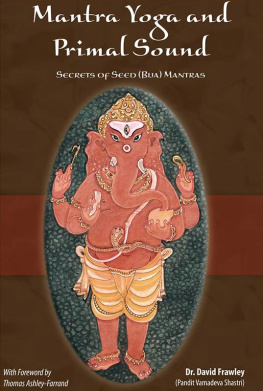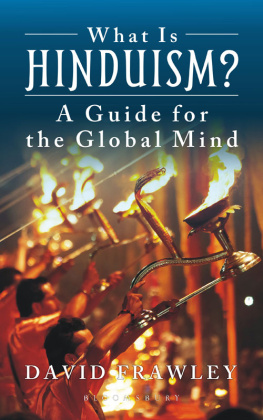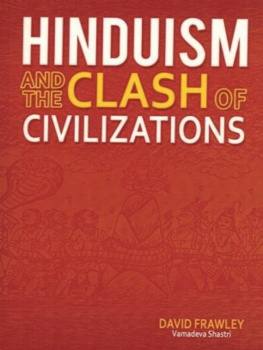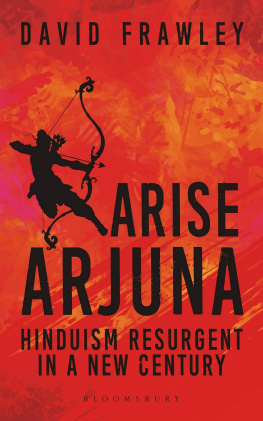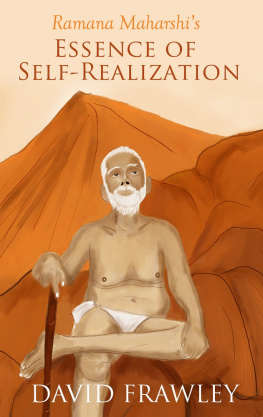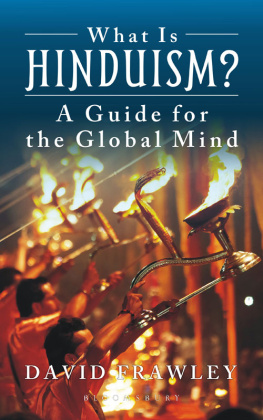David Frawley - Inner Tantric Yoga
Here you can read online David Frawley - Inner Tantric Yoga full text of the book (entire story) in english for free. Download pdf and epub, get meaning, cover and reviews about this ebook. year: 2012, publisher: Lotus Press, genre: Religion. Description of the work, (preface) as well as reviews are available. Best literature library LitArk.com created for fans of good reading and offers a wide selection of genres:
Romance novel
Science fiction
Adventure
Detective
Science
History
Home and family
Prose
Art
Politics
Computer
Non-fiction
Religion
Business
Children
Humor
Choose a favorite category and find really read worthwhile books. Enjoy immersion in the world of imagination, feel the emotions of the characters or learn something new for yourself, make an fascinating discovery.
- Book:Inner Tantric Yoga
- Author:
- Publisher:Lotus Press
- Genre:
- Year:2012
- Rating:3 / 5
- Favourites:Add to favourites
- Your mark:
- 60
- 1
- 2
- 3
- 4
- 5
Inner Tantric Yoga: summary, description and annotation
We offer to read an annotation, description, summary or preface (depends on what the author of the book "Inner Tantric Yoga" wrote himself). If you haven't found the necessary information about the book — write in the comments, we will try to find it.
Inner Tantric Yoga — read online for free the complete book (whole text) full work
Below is the text of the book, divided by pages. System saving the place of the last page read, allows you to conveniently read the book "Inner Tantric Yoga" online for free, without having to search again every time where you left off. Put a bookmark, and you can go to the page where you finished reading at any time.
Font size:
Interval:
Bookmark:

Table of Contents
By David Frawley

P.O. Box 325
Twin Lakes, WI 53181 USA
DISCLAIMER
This is a reference work that is not intended to treat, diagnose or prescribe. The information contained herein is in no way to be considered a substitute for consultation or treatment by a duly licensed health care professional.
COPYRIGHT 2008 by DAVID FRAWLEY
ALL RIGHTS RESERVED. No part of this book may be reproduced in any form or by any electronic or mechanical means including information storage and retrieval systems without permission in writing from the publisher, except by a reviewer who may quote brief passages in a review.
COMPOSITION/LAYOUT: Trice Atkinson
COVER ART: Hinduism Today Magazine
LINE DRAWINGS: Kanika Tripathi COPY EDITING: Margo Bachman Printed in the United States of America
Library of Congress Cataloging-in-Publication Data: 2008921059
ISBN: 978-0-9406-7650-3
Published by:Lotus Press, P.O. Box 325, Twin Lakes, Wisconsin 53181 USAweb: www.lotuspress.come-mail: lotuspress@lotuspress.com800-824-6396
Yoga is such a big part of Western culture these days that most of us believe were already aware of everything it has to offer. After all, Hatha Yoga classes are available everywhere people exercise together, and yogic stress reduction techniques are taught at medical clinics around the country. Everyone knows how healthy a vegetarian diet is, and that meditation produces an impressive array of psychological and physiological benefits. This resume is dazzling enough; what more could there be?
Plenty, it turns out. In fact the more time I spend with traditionally trained yogis and yoginis from India, the more amazed I am at how little of the authentic tradition has reached our shores. Its as if the yoga masters feed us small pieces of it at a time, as much as people raised in our far more materialistic culture are able to assimilate. Only after weve had a chance to digest those teachings do they reveal more advanced techniques and insights.
Looking back, its easy to see that yoga swept into Western culture in waves. In 1893 Swami Vivekananda first introduced Americans and Europeans to the four great paths: Raja Yoga (physical and mental exercises), Jnana Yoga (the intellectual quest for spiritual experience), Bhakti Yoga (devotion) and Karma Yoga (the practical yoga of enlightened daily activity). In the 1930s Paramahamsa Yogananda initiated Western students into Kriya Yoga, which focused on subtle inner experiences involving the gradual arousal of Kundalini. But it was in the late 1960s that yoga leapt from the fringes of American culture into the mainstream when, thanks to adepts like Maharishi Mahesh Yogi and Swami Rama, claims about yogas astounding physical effects were finally validated in scientific research studies. Then in the late 1980s Indias yoginis (female yogis) began making their mark here, often emphasizing the spiritual value of social service.
But what is the next wave? Important elements of the yoga tradition elements considered absolutely essential by most practitioners in India remain virtually unknown in the West. Ironically, this was not always the case. Historians of Western religious traditions have shown that some of these elements were known to the ancient Greeks and Romans, and were even embraced by many early Christians. Tragically, during the Dark Ages a great deal of spiritual lore disappeared in Europe. The long lost wisdom of the ancients was preserved in India however, and beckons us to reclaim it. Are we ready for even deeper and more powerful dimensions of yoga practice?
Most of us first get involved with yoga not because we want to be enlightened but because we want to be healthy. Were got our hands full dealing with the world around us; we dont want to devote hours a day to inner realms when contending with the outside world is challenging enough. We just want to learn some yoga postures and maybe a few tips about cooking healthier meals. But yoga opens the door to inner experience whether we consciously turn the doorknob or not. After an hour of hatha poses and yogic breathing we feel incredible. Were experiencing a level of clarity and tranquility, of focus and well being, that weve rarely touched before. We get to know ourselves in a whole new way, as a calm, bright, creative soul rather than a restless, worried, chronically dissatisfied mind . Yoga practice has carried us beyond our body and thought processes, and introduced us to spirit .
This is the point where many students start exploring yoga philosophy and sign up for meditation classes. We learn a whole new vocabulary for amazing inner states that English doesnt even have words for, but that yoga texts describe in detail. We become eager to experience these extraordinary states ourselves. Enlightenment is no longer just an abstraction to us it becomes an actual goal.
But then, for many yoga students, something goes wrong. As I travel around the United States visiting different yoga centers, students report a common problem: they complain their meditation practice eventually becomes so lifeless, its difficult to stick with it. Theyve been taught to sit mechanically counting their mantras as if they were spiritual accountants, or to work with their posture and breath as if yoga was nothing more than a clever way to manipulate their nervous system. No wonder theyre bored and uninspired!
Its time for the next wave of yogic wisdom to surge across our shores. There is so much more the masters have to share; if were ready for this knowledge it will sweep us past the stuck points in our practice to a vastly expanded experience of spirituality. This is the aspect of yoga science that cracks us out of our self-preoccupation and opens our meditation to the universal forces flowing around us and through us. This is the knowledge the adepts in India use to lift and expand their personal practice, to connect with the living universe in a way that galvanizes their spiritual life. The secret openly known throughout India but barely hinted at in the West is the Devata , the inner deities or cosmic powers of yoga.
In the book you now hold in your hands, Dr. David Frawley will introduce you to the Devatas that lie at the heart of traditional yogic practice. (You should be aware that Devatas were also recognized by spiritual masters like Socrates, Iamblichus and Proclus in the West centuries ago.) The Devatas are the living intelligence in nature, sparks of spirit that guide and illumine, divine beings weve called angels in the West without really understanding what angels are. These are the forces that make mantras, yantras and mandalas come alive, that activate our intuitive powers, and that assist and protect us in the state after death.
In all my years of studying the sacred tradition in India, Ive never met a yogi or yogini who wasnt actively engaged with these powerful inner energies. They link us with the many Shaktis or powers that govern the physical and subtle worlds. They serve as bridges to higher fields of consciousness.
In one sense Devatas are wholly the hidden powers of our own superconscious mind. In another sense they are independent entities operating outside us. In reality they are rooted in a transcendent realm where the distinctions inner and outer no longer have any relevance. To practitioners in India, theyre the essence of spiritual life.
For thousands of years incorporating the Devatas into ones spiritual practice has made inner discipline a pleasure, transforming meditation from mental drudgery into heartfelt worship. Meditation comes alive when Shakti, the power of consciousness, is activated. This is the next level of practice for serious yoga students, a whole new realm of spiritual experience for intrepid inner explorers.
Next pageFont size:
Interval:
Bookmark:
Similar books «Inner Tantric Yoga»
Look at similar books to Inner Tantric Yoga. We have selected literature similar in name and meaning in the hope of providing readers with more options to find new, interesting, not yet read works.
Discussion, reviews of the book Inner Tantric Yoga and just readers' own opinions. Leave your comments, write what you think about the work, its meaning or the main characters. Specify what exactly you liked and what you didn't like, and why you think so.


